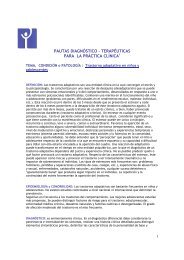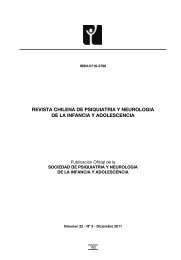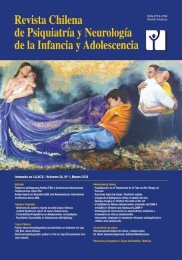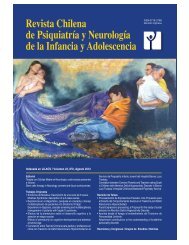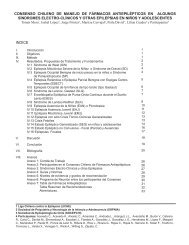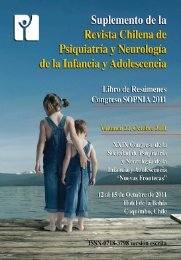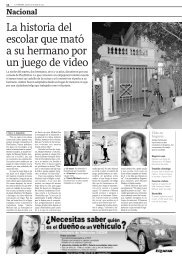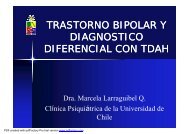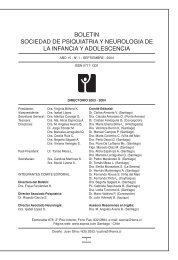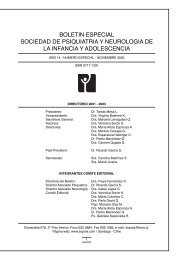revista chilena de psiquiatria y neurologia de la infancia
revista chilena de psiquiatria y neurologia de la infancia
revista chilena de psiquiatria y neurologia de la infancia
Create successful ePaper yourself
Turn your PDF publications into a flip-book with our unique Google optimized e-Paper software.
CONTRIBUCIONES<br />
Rev. Chil. Psiquiatr. Neurol. Infanc. Adolesc. Año 18, Nº 2, Diciembre 2007<br />
Trastorno afectivo bipo<strong>la</strong>r: Evaluación <strong>de</strong> cambios<br />
funcionales cerebrales a partir <strong>de</strong> <strong>la</strong> técnica<br />
Neuro-SPECT Tc99m HMPAO<br />
Ismael Mena 1 , Rodrigo Correa, Armando Na<strong>de</strong>r, Virginia Boehme<br />
RESUMEN<br />
El trastorno afectivo bipo<strong>la</strong>r (TAB) se presenta<br />
en todas <strong>la</strong>s culturas con una prevalencia que<br />
osci<strong>la</strong> entre 3 y 6.5 %. La naturaleza <strong>de</strong> sus<br />
manifestaciones clínicas y curso evolutivo lo<br />
p<strong>la</strong>ntean como un <strong>de</strong>safío diagnóstico y terapéutico<br />
aún para el clínico experimentado. Se<br />
ha analizado, a partir <strong>de</strong> <strong>la</strong> técnica <strong>de</strong> Neuro<br />
SPECT, <strong>la</strong> expresión neuro-funcional cortical y<br />
sub-cortical para una cohorte <strong>de</strong> 44 pacientes<br />
eutímicos con criterios DSM IV compatibles<br />
con el diagnóstico <strong>de</strong> TAB. Los resultados fueron<br />
expresados en imágenes tridimensionales<br />
normalizadas por volumen y comparadas con<br />
una base <strong>de</strong> datos normativa <strong>de</strong> acuerdo a <strong>la</strong><br />
edad <strong>de</strong>l paciente. El análisis cuantitativo consi<strong>de</strong>ró<br />
<strong>la</strong> región <strong>de</strong> máxima perfusión en cada<br />
área <strong>de</strong> Brodmann con significado conductual.<br />
Los resultados fueron expresados en términos<br />
<strong>de</strong> Desviación Standard (DS) respecto <strong>de</strong> <strong>la</strong><br />
pob<strong>la</strong>ción control empleando una esca<strong>la</strong> <strong>de</strong><br />
colores apropiada, consi<strong>de</strong>rándose este valor<br />
como una variable continua susceptible <strong>de</strong><br />
analizar estadísticamente. A nivel cortical se<br />
reporta presencia <strong>de</strong> hiperperfusión en subregiones<br />
<strong>de</strong> áreas 8, 9 y 10 <strong>de</strong> Brodmann (área<br />
ejecutiva), así como en área 7 <strong>de</strong> Brodmann<br />
(lóbulo parietal posterior). Se <strong>de</strong>scribe, a<strong>de</strong>más,<br />
hipoperfusión re<strong>la</strong>tiva en áreas 24 y 32<br />
(lóbulo frontal interno), área 25 (área afectiva)<br />
y área 21,22 y 38 (lóbulo temporal). En estructuras<br />
sub-corticales se reporta hiperperfusión<br />
<strong>de</strong> Tá<strong>la</strong>mo, Caudado y núcleo Lentiforme con<br />
valores superiores a 3 DS por sobre <strong>la</strong> pob<strong>la</strong>ción<br />
control. A partir <strong>de</strong> los datos obtenidos<br />
es posible p<strong>la</strong>ntear <strong>la</strong> presencia <strong>de</strong> marcadores<br />
neuro-funcionales <strong>de</strong> rasgo utilizables<br />
1 Departamento <strong>de</strong> Medicina Nuclear, Clínica Las Con<strong>de</strong>s.<br />
Trabajo publicado en A<strong>la</strong>sbimn Journal 6(23): Enero<br />
2004. Artículo NºAJ23-1.<br />
Trabajo recibido 22 Septiembre 2007. Aceptado para<br />
publicación 5 Octubre 2007.<br />
como una herramienta <strong>de</strong> apoyo diagnóstico.<br />
Los datos obtenidos permiten postu<strong>la</strong>r <strong>la</strong> participación<br />
<strong>de</strong> circuitos cortico-sub-corticales<br />
como probable sustrato etiológico en trastorno<br />
afectivo bipo<strong>la</strong>r.<br />
Pa<strong>la</strong>bras C<strong>la</strong>ve: Trastorno Afectivo Bipo<strong>la</strong>r,<br />
SPECT, HMPAO.<br />
SUMMARY<br />
Bipo<strong>la</strong>r affective disor<strong>de</strong>r (B.D.) has a prevalence<br />
of 3- 6.5% of the popu<strong>la</strong>tion. Its clinical<br />
presentation and clinical evolution are a diagnostic<br />
and therapeutic challenge even for the<br />
skilled clinician. We report on neurofunctional<br />
cortical and subcortical changes <strong>de</strong>monstrated<br />
by Neuro-SPECT in a cohort of 44 eutimic<br />
patients with diagnosis compatible with DSMV<br />
IV criteria for B.D.<br />
In the cortex Neuro-SPECT <strong>de</strong>monstrated<br />
increased perfusion in areas 8, 9 and 10 of<br />
Brodmann (executive cortex), also in area 7<br />
of Brodmann (posterior parietal lobe). Furthermore,<br />
there is hypoperfusion in area 24 and 32<br />
of Brodmann (anterior and pre cingu<strong>la</strong>te gyrus),<br />
area 25, subgenual area (affective), and<br />
area 21, 22 and 38 in the temporal lobes. In<br />
subcortical areas we report increased perfusion<br />
> 3 SD above normal controls in tha<strong>la</strong>mus,<br />
caudate and lentiform nucleus. Based on<br />
these findings, Neuro-SPECT may constitute<br />
a useful diagnostic tool in bipo<strong>la</strong>r affective disor<strong>de</strong>r.<br />
These data also support the hypothesis<br />
of abnormality of cortical-subcortical circuitry<br />
in bipo<strong>la</strong>r affective disor<strong>de</strong>r.<br />
Key Words. Bipo<strong>la</strong>r affective disor<strong>de</strong>r,<br />
SPECT, HMPAO.<br />
INTRODUCCION<br />
Durante los últimos años, <strong>la</strong>s técnicas <strong>de</strong> Neu-<br />
41



